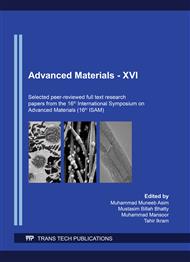[1]
H. M Barkholtz, L Chong, ZB Kaiser, DJ Liu. Non-Precious Metal Catalysts Prepared By Zeolitic Imidazolate Frameworks: The Ligand Influence to Morphology and Performance. Fuel Cells 16 (2016) 428–33.
DOI: 10.1002/fuce.201500164
Google Scholar
[2]
S Ma, GA Goenaga, A V.Call, D-J. Liu Cobalt Imidazolate Framework as Precursor for Oxygen Reduction Reaction Electrocatalysts. Chem - A Eur. J. 17 (2011) 2063–(2067).
DOI: 10.1002/chem.201003080
Google Scholar
[3]
D Zhao, J-L Shui, C Chen, X Chen, BM Reprogle, D Wang, et al. Iron imidazolate framework as precursor for electrocatalysts in polymer electrolyte membrane fuel cells. Chem. Sci. 3 (2012) 3200.
DOI: 10.1039/c2sc20657a
Google Scholar
[4]
CH Choi, WS Choi, O Kasian, AK Mechler, MT Sougrati, S Brüller, et al. Unraveling the Nature of Sites Active toward Hydrogen Peroxide Reduction in Fe-N-C Catalysts. Angew Chem Int Ed. Engl. 56 (2017) 8809–8812.
DOI: 10.1002/anie.201704356
Google Scholar
[5]
S Gonen, L.Elbaz Comparison of new metal organic framework-based catalysts for oxygen reduction reaction. Data Br. 19 (2018) 281–287.
DOI: 10.1016/j.dib.2018.05.011
Google Scholar
[6]
D Zhao, J-L Shui, LR Grabstanowicz, C Chen, SM Commet, et al. Highly Efficient Non-Precious Metal Electrocatalysts Prepared from One-Pot Synthesized Zeolitic Imidazolate Frameworks. Adv. Mater. 26 (2014) 1093–1097.
DOI: 10.1002/adma.201304238
Google Scholar
[7]
HA Gasteiger, SS Kocha, B Sompalli, FT Wagner. Activity benchmarks and requirements for Pt, Pt-alloy, and non-Pt oxygen reduction catalysts for PEMFCs. Appl. Catal. B Environ. 56 (2005) 9–35.
DOI: 10.1016/j.apcatb.2004.06.021
Google Scholar
[8]
B Liu, H Shioyama, T Akita, Q Xu. Metal-Organic Framework as a Template for Porous Carbon Synthesis. J. Am. Chem. Soc. 130 (2008) 5390–53901.
DOI: 10.1021/ja7106146
Google Scholar
[9]
A Franco, M Cano, JJ Giner-Casares, E Rodríguez-Castellón, R Luque, AR Puente-Santiago. Boosting the electrochemical oxygen reduction activity of hemoglobin on fructose@graphene-oxide.
DOI: 10.1039/c9cc01625b
Google Scholar
[10]
S-B Ren, J Wang, X-H Xia. Highly Efficient Oxygen Reduction Electrocatalyst Derived from a New Three-Dimensional PolyPorphyrin. ACS Appl. Mater. Interfaces. 8 (2016) 25875–25880.
DOI: 10.1021/acsami.6b05560
Google Scholar
[11]
P Yin, T Yao, Y Wu, L Zheng, Y Lin, W Liu, et al. Single Cobalt Atoms with Precise N-Coordination as Superior Oxygen Reduction Reaction Catalysts. Angew. Chemie. Int. Ed. 55 (2016) 10800–10805.
DOI: 10.1002/anie.201604802
Google Scholar
[12]
SA Moggach, TD Bennett, AK Cheetham. The Effect of Pressure on ZIF-8: Increasing Pore Size with Pressure and the Formation of a High-Pressure Phase at 1.47 GPa. Angew Chemie. Int. Ed. 48 (2009) 7087–7089.
DOI: 10.1002/anie.200902643
Google Scholar
[13]
F Wang, Y-X Tan, H Yang, H-X Zhang, Y Kang, J Zhang. A new approach towards tetrahedral imidazolate frameworks for high and selective CO2 uptake. Chem. Commun. 47 (2011) 5828.
DOI: 10.1039/c1cc10829h
Google Scholar
[14]
C Zhang, Y-C Wang, B An, R Huang, Wang C, Z Zhou, et al. Networking Pyrolyzed Zeolitic Imidazolate Frameworks by Carbon Nanotubes Improves Conductivity and Enhances Oxygen-Reduction Performance in Polymer-Electrolyte-Membrane Fuel Cells. Adv. Mater. 29 (2017) 1604556.
DOI: 10.1002/adma.201604556
Google Scholar
[15]
A Zitolo, Goellner V, V Armel, M-T Sougrati, T Mineva, L Stievano, et al. Identification of catalytic sites for oxygen reduction in iron- and nitrogen-doped graphene materials. Nat. Mater. 42 (2015) 937–942.
DOI: 10.1038/nmat4367
Google Scholar
[16]
H Yu, A Fisher, D Cheng, D Cao. Cu,N-codoped Hierarchical Porous Carbons as Electrocatalysts for Oxygen Reduction Reaction. ACS Appl. Mater. Interfaces. 8 (2016) 21431–9.
DOI: 10.1021/acsami.6b04189
Google Scholar
[17]
H Yu, L Yang, D Cheng, D Cao. Engineered Science Zeolitic-imidazolate Framework (ZIF) ZnCo-ZIF Core-shell Template-derived Co, N-doped Carbon Catalysts for Oxygen Reduction Reaction 2018.
Google Scholar
[18]
M Thomas, R Illathvalappil, S Kurungot, BN Nair, AAP Mohamed, GM Anilkumar, et al. Graphene Oxide Sheathed ZIF-8 Microcrystals: Engineered Precursors of Nitrogen-Doped Porous Carbon for Efficient Oxygen Reduction Reaction (ORR) Electrocatalysis. ACS Appl. Mater. Interf. (2016) 29373–82.
DOI: 10.1021/acsami.6b06979
Google Scholar
[19]
M S Saha, V Neburchilov, D Ghosh, J Zhang. Nanomaterials-supported Pt catalysts for proton exchange membrane fuel cells. Wiley Interdiscip Rev. Energy. Environ. 2 (2013) 31–51.
DOI: 10.1002/wene.47
Google Scholar
[20]
S Rakshit, S Ghosh, S Chall, SS Mati, SP Moulik, SC Bhattacharya. Controlled synthesis of spin glass nickel oxide nanoparticles and evaluation of their potential antimicrobial activity: A cost effective and eco friendly approach. RSC Adv. 3 (2013) 19348–56.
DOI: 10.1039/c3ra42628a
Google Scholar


